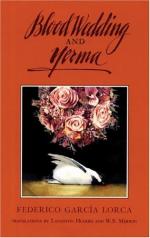|
This section contains 3,957 words (approx. 14 pages at 300 words per page) |

|
Analysis of "Blood Wedding"
Summary: Federico Garcia Lorca's three plays, "Blood Wedding," "Yerma," and "The House of Bernarda Alba" share many symbolisms. These unconscious symbols are known as archetypes, developed by the psychologist, Carl G. Jung. Analysis better explains some of the unconscious meaning and original thoughts behind Lorca's symbols. This is important because a detailed reading will allow the reader to clearly understand each symbol and why it is important to the society in the play, and to Lorca's society.
Federico Garcia Lorca's three plays, "Blood Wedding," "Yerma," and "The House of Bernarda Alba" share many symbolisms. Lorca (Short Biography) wrote about many subjects and objects that often have an unconscious double meaning. These unconscious symbols are known as archetypes, developed by the psychologist, Carl G. Jung. This paper will analyze these symbols using Jung's theory of the archetype. By doing so, the analysis will better explain some of the unconscious meaning and original thoughts behind Lorca's symbols. This is important because a detailed reading will allow the reader to clearly understand each symbol and why it is important to the society in the play, and to Lorca's society.
To begin, Jung explains that an archetype is an inherited idea or thought derived from the experiences of the society and present in the unconscious of the individual. The archetype depends heavily on the collective unconscious. The unconscious is...
|
This section contains 3,957 words (approx. 14 pages at 300 words per page) |

|


